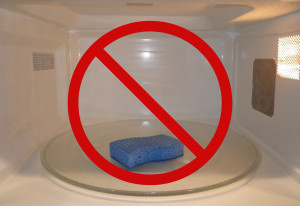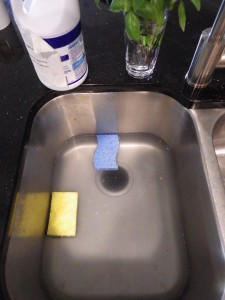 Kitchen sponges. Some people love them and others wince at the thought of that bacteria-breeding creature in their kitchen.
Kitchen sponges. Some people love them and others wince at the thought of that bacteria-breeding creature in their kitchen.
(With that statement I bet you know my thoughts on the subject).
Sponges are great for wiping up spills and absorbing liquid. Some even have a scrubby side that helps clean grime from pots, pans and dishes. However, in the course of performing these services, sponges also absorb harmful foodborne pathogens along the way. There have been some scientific studies that show that kitchen sponges (and/or dish rags) are the germiest places in most homes. If they’re not cleaned between uses, then they can be a prime spot for germ growth.
If you love your sponge, here are some ways to keep it clean…
- Clean it daily and replace it frequently. If it starts to smell, pitch it.
- Wring the sponge out completely after each use and wash off any loose food or debris.
- Try to allow it to dry out.
- Don’t use the sponge to wipe up meat or poultry juices. Clean these types of spills with paper towels or something that you can throw away.
- Don’t use sponges on countertops. Germs and bacteria can easily spread from the sponge to the counter, and then you spread it all around. Paper towels or disinfectant wipes are better to use on countertops.
 Now let’s talk about sanitizing the sponge.
Now let’s talk about sanitizing the sponge.
Several reputable organizations and websites recommend heating sponges in a microwave on high for one to two minutes. These sites say that this process kills 99% of possible bacteria.
However, there are a couple of concerns here. According to the American Cleaning Institute, microwaving a sponge could be risky. Unless the sponge is soaking wet, there is the possibility of starting a fire inside the microwave. In addition, the size of the sponge and the amount of power in the microwave are variables that influence how long you would need to zap it to kill germs.
If you “nuke” that sponge and think you’ve solved the bacteria problem, you may need to re-think that process.
A better way of keeping a sponge clean is to soak it for five minutes in a solution of one quart water to three tablespoons of chlorine bleach and then let the sponge air-dry.
A pro-active approach to cleaning that kitchen sponge is to put the bleach and water solution into my sink and soak the sponge in it as well as swish it around the sink. This helps with a couple of different potential dirty areas and will help clean the sponge, the sink, and the drain. Oh, and here’s a tip from my own experience, use caution with this beach solution or you’ll end up with bleach spots on your clothes.
By Cheryle Jones Syracuse, MS, Professor Emeritus at The Ohio State Univeristy
But wait, there’s more! At the Nutrition Education Store, that is!





